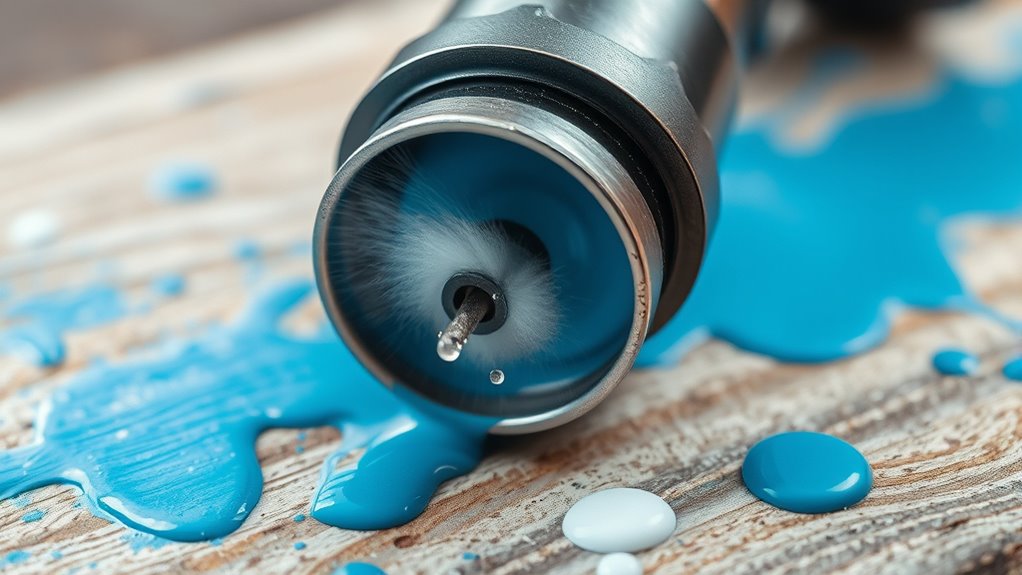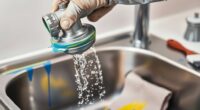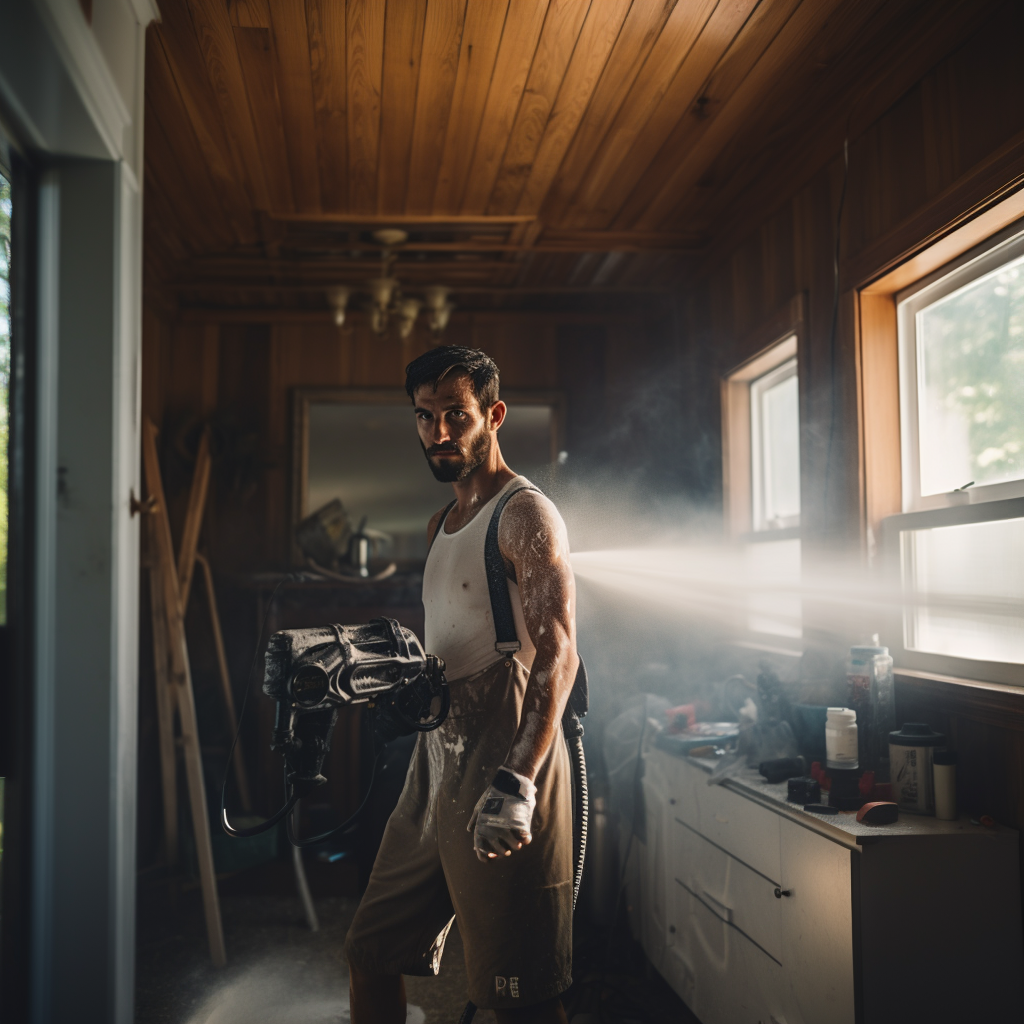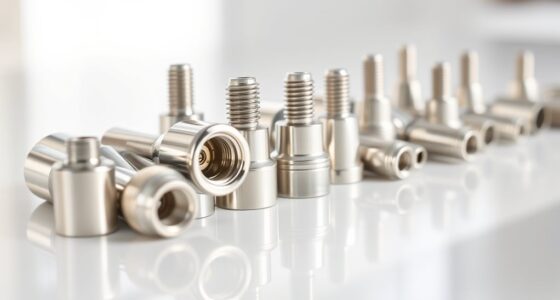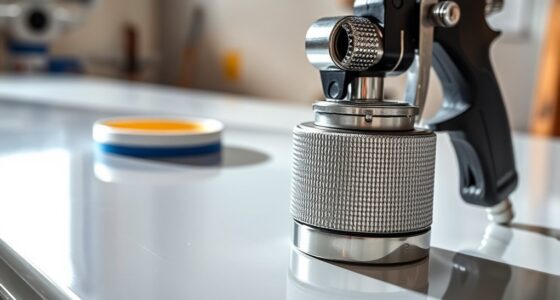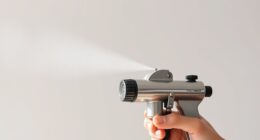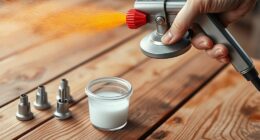If your paint sprayer keeps clogging, it’s often due to dried paint, debris, or thick paint blocking the nozzle. Using unthinned or improperly mixed paint, or not cleaning the spray gun after each use, can lead to buildup and partial blockages. Regular maintenance helps prevent these issues, but persistent clogs might require replacing worn parts. Keep these tips in mind to improve spray performance and avoid interruptions—discover more tips that can help keep your sprayer running smoothly.
Key Takeaways
- Dried or thickened paint inside the nozzle blocks paint flow and causes clogs.
- Debris like dust or dried paint flakes can accumulate and obstruct the nozzle.
- Using unthinned or improperly mixed paint increases the risk of nozzle blockage.
- Residual paint from previous use can dry and cause buildup if not cleaned promptly.
- Worn or damaged nozzles may lead to frequent clogs and spray inconsistencies.
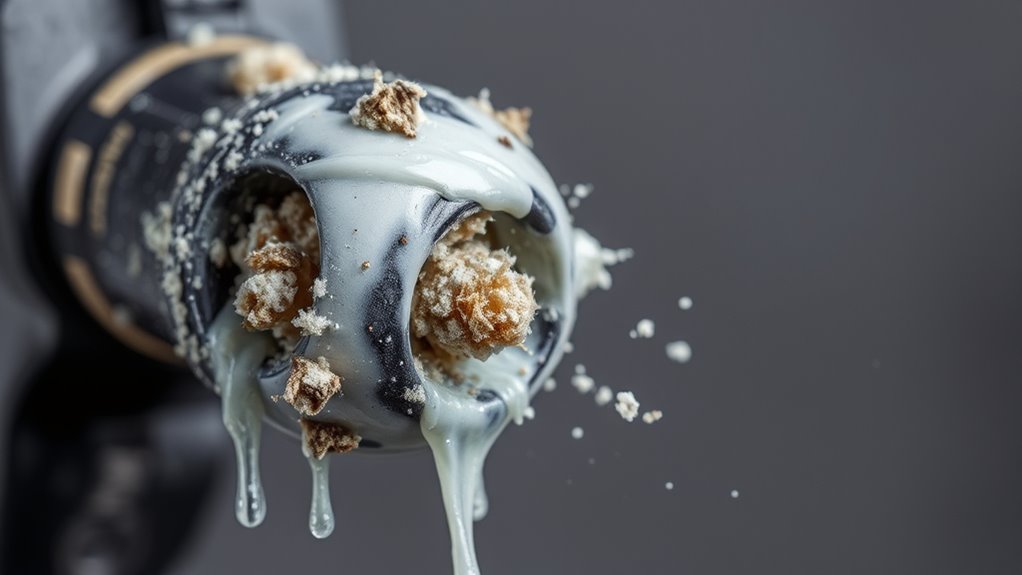
Have you ever experienced a paint sprayer clog right in the middle of your project? It’s frustrating, especially when you’re on a tight schedule or trying to achieve a smooth, professional finish. One common reason for this annoyance is issues with paint flow. When the paint doesn’t flow properly through the sprayer, it can cause uneven spraying, sputtering, or complete blockages. Often, these problems stem from nozzle blockages, which can happen for several reasons. Understanding what’s causing these clogs can help you troubleshoot effectively and keep your project moving smoothly.
Nozzle blockages are a frequent culprit behind sprayer clogs. If the nozzle gets partially or fully blocked, the paint can’t pass through freely, leading to interruptions. Blockages often occur because of dried paint, debris, or thickened material that doesn’t pass easily through the small opening. Paint that’s too thick or not properly mixed can settle or dry inside the nozzle, creating a stubborn blockage. Even tiny bits of dust or dried paint flakes can cause partial blockages, reducing paint flow and causing sputtering or inconsistent spray patterns.
Nozzle blockages from dried paint and debris cause spraying interruptions and uneven finishes.
To prevent nozzle blockages, you need to pay close attention to how you prepare and maintain your sprayer. Always strain your paint before pouring it into the reservoir to remove any debris or lumps. Thinning your paint according to manufacturer instructions also helps ensure it flows smoothly through the nozzle. Thick or unthinned paint increases the risk of clogging. After each use, clean your spray gun thoroughly, especially the nozzle and fluid passages. Use the recommended cleaning tools and solvents to remove any residual paint or dried material, which could otherwise cause future blockages. Additionally, maintaining proper high-quality paint formulations can significantly reduce the risk of clogs, as inferior or improperly mixed paints are more prone to drying and causing blockages.
Another key step is regularly inspecting the nozzle for signs of buildup or damage. If you notice persistent clogs despite proper cleaning, it might be time to replace the nozzle altogether. Worn or damaged nozzles don’t spray evenly and are more prone to blockages. Additionally, avoid leaving paint in the sprayer for extended periods, as drying paint inside the nozzle can be difficult to remove later.
Frequently Asked Questions
Can Using Old Paint Cause My Sprayer to Clog?
Using old paint can definitely cause your sprayer to clog. Over time, paint can dry out or separate, affecting its consistency. When the paint isn’t smooth and uniform, it can block the sprayer’s nozzle or filter. To avoid clogs, always check the paint’s consistency before spraying, and consider stirring or thinning old paint to guarantee it flows smoothly through your sprayer.
Does Temperature Affect Paint Sprayer Clogging?
Temperature definitely impacts your paint sprayer. If the paint temperature’s too low, it thickens, causing spray inconsistency and clogging. Conversely, if it’s too hot, the paint can become too runny, leading to uneven application and potential blockages. Maintaining a consistent paint temperature ensures better spray consistency and reduces clogs. Always check and adjust your paint to the recommended temperature range for ideal performance and a smooth finish.
How Often Should I Clean My Paint Sprayer?
You should clean your paint sprayer after each use to prevent clogs and guarantee peak performance. Follow a maintenance schedule that includes thorough cleaning techniques, such as flushing with the appropriate solvent and inspecting parts regularly. If you’re working on a project with multiple colors, clean the sprayer between colors. Proper maintenance keeps your sprayer working smoothly and extends its lifespan, saving you time and frustration.
Are Certain Paint Types More Prone to Clogging?
Certain paint types are more prone to clogging your sprayer, especially if the paint consistency is too thick or if the nozzle design isn’t suited for that specific paint. Thick paints or those with heavy pigments can easily clog the nozzle, so always check the manufacturer’s recommendations. Using the right nozzle design for your paint type guarantees smooth spraying and reduces the chances of clogs, saving you time and frustration.
Can I Fix a Clogged Sprayer Without Professional Help?
If your paint sprayer is clogged, you can try DIY fixes first, such as cleaning the nozzle and filters thoroughly with water or solvent. Make sure to flush the system and clear any blockages. If these steps don’t work, consider professional repair to avoid damaging the sprayer. Regular maintenance helps prevent future clogs, saving you time and money on repairs.
Conclusion
So, now that you know the common causes behind your paint sprayer clogging, it’s time to take action. But beware—sometimes the culprit isn’t immediately obvious, and a simple fix might not be enough. Will your next spray session go smoothly, or will you face another frustrating clog? Stay vigilant, keep troubleshooting, and don’t give up. The solution could be closer than you think—just waiting for you to uncover it.
Franz came aboard the Paint Sprayer Zone team with a background in both journalism and home renovation. His articulate writing style, combined with a passion for DIY projects, makes him an invaluable asset. Franz has a knack for breaking down technical jargon into easy-to-understand content, ensuring that even the most novice of readers can grasp the complexities of paint sprayers.
